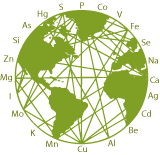Uranium U-238
U-238 occurs naturally in nearly all rock, soil, and water.
Of the uranium isotopes, U-238 is the most abundant form in the environment and is found the rock, soil and water of certain geological areas. It can also be found in phosphate fertilizers.
Uranium mining and production is carried out in about 13 countries around the world, in 2017 producing a cumulative total of 59,462 tonnes of uranium (tU). The international producers were Kazakhstan (39%), Canada (22%), Australia (10%), Namibia (7.1%), Niger (5.8%), Russian Federation (4.9%), Uzbekistan (4.0%), China (3.2%), United States (1.6%), Ukraine (0.9%), India (0.7%), South Africa (0.5%) and Pakistan (0.1%). Since 2009 the in-situ leach (ISL) operations of Kazakhstan have been producing the largest share of world uranium.
U-238 contains 99.284% uranium-238, 0.711% uranium-235,and a trace of uranium-234 by weight (0.0055%).
U-235 and DU (Depleted Uranium)
Depleted uranium (DU) is created as a waste product when the radioactive isotope uranium-235 is extracted from natural uranium ore. As a by-product of the uranium-enrichment process, DU is plentiful. It is also extremely costly to dispose of because of its radioactivity. As a result, arms manufacturers can obtain depleted uranium for minimal or even no cost. Because it is exceptionally dense, depleted uranium can be used in the production of tank armour or made into ammunition. Depleted uranium rounds penetrate conventional armour easily and ignite on impact, usually causing extensive damage to the target. Weapons using DU have been used in wars (Kosovo, Iraq, Afghanistan) since 1991.
Although the U.S. military and many medical experts maintain that depleted uranium poses no significant threat to human health, in sufficient concentrations the substance can contaminate soil and water supplies. The World Health Organization has identified a number of locations in Bosnia and Kosovo that require cleanup.
Testing for Uranium
At Micro Trace Minerals Laboratory, we are mainly testing the isotope U-238 in blood, urine, hair and other specimen.
If your test results indicate test values above the existing reference range, find out from your local authorities if you live in an area of elevated uranium deposits in soil and rocks, and if your local drinking water contains measurable uranium levels.
At this time, we know of no medical treatment that can reduce uranium after exposure has occurred.
Information for Emergency Treatment
For more information about uranium exposure, see
In case of radiation exposure due or exposure to enriched uranium or nuclear fallout, check this link.
https://emergency.cdc.gov/radiation/isotopes/pdf/uranium.pdf
